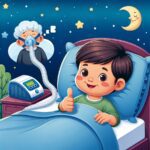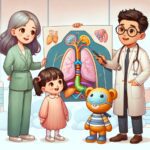Recognizing signs of sleep apnea in infants is crucial for any parent or caregiver. Sleep apnea, a condition where breathing repeatedly stops and starts during sleep, can significantly affect a baby’s rest and overall health. This comprehensive guide delves into the symptoms, risks, and effective management strategies to safeguard your infant’s well-being.
What is Sleep Apnea in Infants?
Sleep apnea in infants manifests differently than in adults, with pauses in breathing that may last from a few seconds to minutes. These interruptions can occur multiple times per hour and are often accompanied by a noticeable effort to resume breathing. Understanding these patterns is key to identifying sleep apnea at its onset.
There are primarily two types of infant sleep apnea: Central and Obstructive. Central Sleep Apnea (CSA) occurs when the brain does not send proper signals to the muscles controlling breathing. Obstructive Sleep Apnea (OSA), more common in older infants, happens when there’s a physical blockage in the airway. In some cases, infants can experience a mix of both types, known as Mixed Sleep Apnea.
Signs of Sleep Apnea in Infants
Detecting signs of sleep apnea in infants early can prevent potential health issues. Common indicators include: snoring or noisy breathing, prolonged pauses in breathing, gasping or choking during sleep, restlessness, and unusual sleep positions, such as the neck being arched backward. Parents might also notice their infant experiencing daytime sleepiness or feeding difficulties, which are indirect symptoms of disturbed sleep.
It’s essential for parents to monitor their baby’s sleep patterns and consult a healthcare provider if they suspect sleep apnea. Early diagnosis and intervention can mitigate risks associated with the condition, such as developmental delays and heart problems.
Managing Sleep Apnea in Infants
Management and treatment of infant sleep apnea depend on its severity and the underlying cause. In mild cases, simple measures, such as adjusting the sleeping position or ensuring the baby’s airway is clear of obstructions, might suffice. More severe cases may require medical interventions like Continuous Positive Airway Pressure (CPAP) therapy or supplemental oxygen.
Besides medical treatment, creating a conducive sleep environment is vital. Ensure the crib mattress is firm and flat, and remove soft bedding and toys that could obstruct breathing. Monitoring room temperature and using a [humidifier](https://www.healthline.com/health/humidifiers-and-health#benefits) can also promote easier breathing.
For further reading on enhancing your baby’s sleep quality, consider exploring topics like establishing a sleep schedule for a newborn, safe co-sleeping practices, and ideal room temperature for baby sleep in winter.
Recognizing and addressing signs of sleep apnea in infants is a critical step in ensuring the health and development of your baby. With the right knowledge and proactive measures, parents can significantly reduce the impact of this condition.
For more information on sleep-related issues in infants, don’t hesitate to consult resources on the role of REM sleep in infant development, safe sleep aids for babies, and dealing with sleep regression at 9 months.













